Eugenia, Clove, Ding Xiang 丁香Caryophyllatus aromaticusAnthophyllum: Mother Cloves: Mature Cloves Lavanga (Ayurveda) Kirambu, Ilavankam (Siddha) Ding Xiang (TCM); Mother Clove is Mu Ding Xiang (literally “Mother Clove”) Li Shi ལི་ཤི (Tibetan) Qaranful (Unani) |
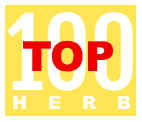
|
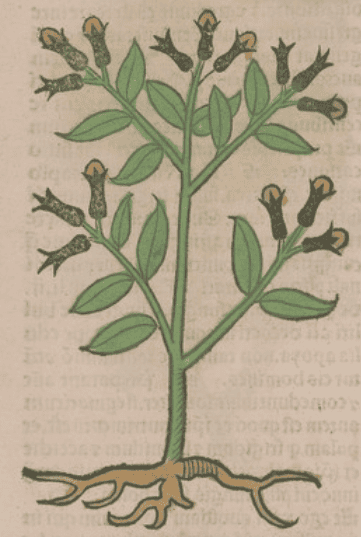 Ortus Sanitatis, Meydenbach, 1491
Ortus Sanitatis, Meydenbach, 1491
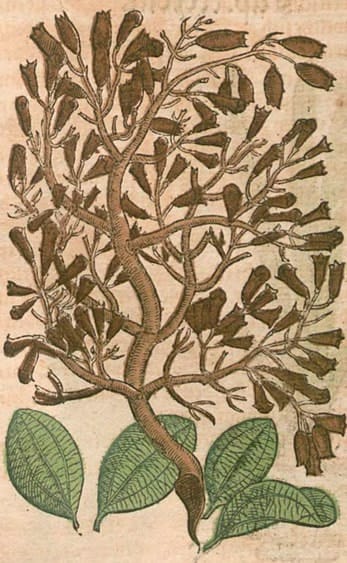
|
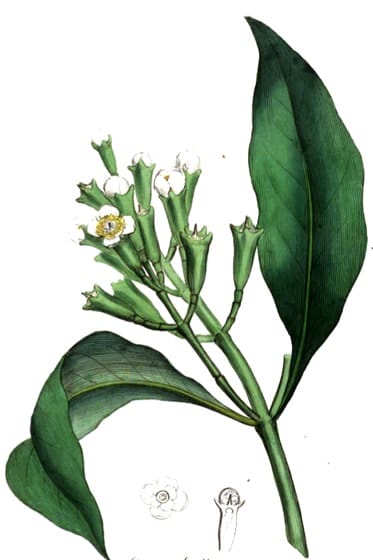
|
|
Krauterbuch, Lonitzer, 1578 |
Medical Botany, Woodville, Hooker, Vol. 3, 1832 |
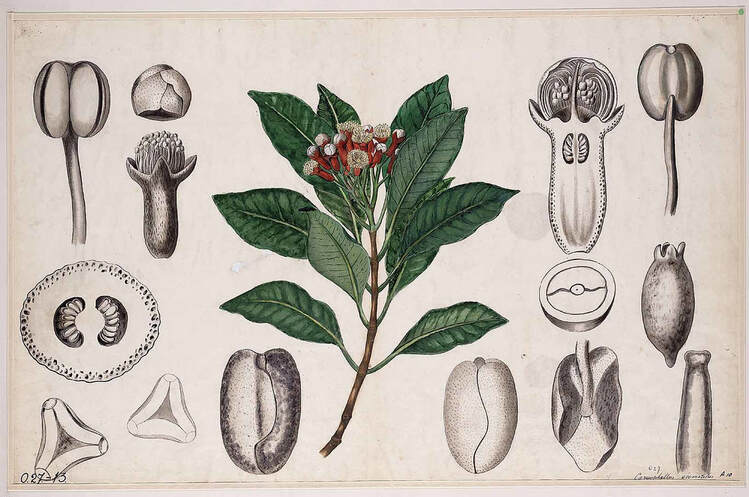 Botanische wandplaten, 1904–1914
Botanische wandplaten, 1904–1914
 Anthophyllum or ‘Mother Clove’
Anthophyllum or ‘Mother Clove’Notes on Pharmacognosy, Otto Augustus Wall, 1902 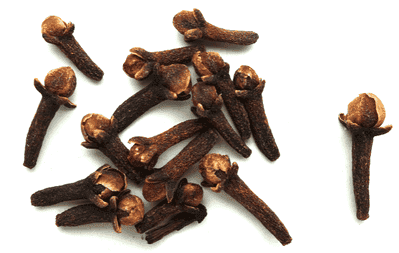
|
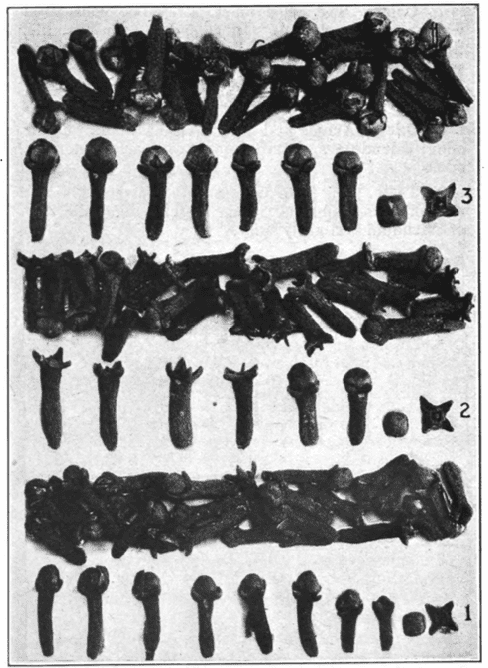
|
|
Above: Clove (Adam, 2016) |
1, Zanzibar Cloves. 2, Amboyna Cloves. 3, Penang Cloves. Squibb’s Atlas of the Official Drugs, Mansfield, 1919 |
Botanical name:
Eugenia caryophyllus (syn. Syzygium aromaticum, S. caryophyllatum, Caryophyllatus aromaticus)
Parts used:
Dried flower bud;
‘Mother Cloves’ are the dried mature Clove
Temperature & Taste:
Hot, dry. Pungent
“Hot and dry in the third degree” (Avicenna)
Ayurveda considers Clove to have a Cool action
Classification:
2A APERIENT MEDICINES. 2B ATTENUATER. 2H. CARMINATIVE. 2I. ANTISPASMODIC. 2Q. ANODYNE
3A. SUDORIFICS & DIAPHORETICS. 3C. ALEXIPHARMIC. 3D. CORDIALS & CARDIACS. 3I. APHRODISIAC.
3J. INCREASE SEMEN
4a. CEPHALIC. 4b. OPTHALMIC. 4c. CARDIAC. 4e. STOMACHIC. 4g. HEPATIC. 4h. NEPHRITIC. 4i. UTERINE.
4j. NERVINE
TCM:
M. Warm to Expel Cold
Uses:
1. Settles Wind, Regulates Qi, Opens Obstructions, Eases Pain:
-important medicine for Wind diseases: it courses and regulates the Qi, penetrating turbidity and settling disordered Qi
-excellent for the Head; good for Fainting, Headache, Migraine, Vertigo, Dizziness, Toothache
-Epilepsy, Paralysis, Trembling, Parkinsonism
-benefits the Heart; good when Wind is affecting the Heart
-“Cloves, when taken orally or applied as a kohl (collyrium), strengthen the Eye-sight‘ (Avicenna)
2. Warms the Stomach, Clears Cold:
-good for the Stomach; used for ‘crudities’ (undigested food) of the Stomach
–Hiccup, Vomiting, Dyspepsia, Diarrhea, Nausea
-“It strengthens the Stomach and Liver and proves to be useful in Vomiting and Nausea” (Avicenna)
3. Warms the Lungs, Clears Cold Phlegm, Stops Cough:
-Cough, Bronchitis and Tuberculosis
-Throat diseases, Hoarseness, Pharyngitis
4. Warms the Kidneys, Clears Cold and Damp:
–Edema, chronic Nephritis, Urinary disorders, Arthritis
-Impotence from cold; Infertility
-used for Cold diseases of the Womb, Leukorrhea
5. Resists Poison:
–Colds, Influenza, Infectious Diseases
-Cholera, Leprosy, Gonorrhea
-good for Malignant diseases
6. Kills Worms:
-especially Round- and Tape-worm
-also Lice and Ticks
7. Externally:
-oil is applied to Toothache, or a clove can be placed over the gum
–oil is much used in oils, liniments, plasters for Joint Pain, Arthritis, Rheumatism, Bursitis, Neuralgia and degeneration of the bones
–a few Cloves boiled in sesame oil, and three drops of the warm oil dropped into the ear is effective for Earache and Tinnitus.
–Clove dipped in water and applied to a stye gives great relief
–powdered Clove is applied to cracked Nipples
-the oil is applied to Tinea and Ringworm
Comment:
1. Occasionally, ‘Mother Cloves’ (Anthophyllum) is called for in classical formulas. These are Cloves that have fully ripened and can be as large as a thumb, our regular Cloves being buds. The have a fragrant gum in them and were generally regarded as stronger, but similar, to normal Cloves. The main formula that listed them was Diacameron (Diathamaron) of Nicholas.
2. Confected Cloves warm and strengthen the Stomach, clear crudities from it, expel Wind, and strengthen Nature.
Dose:
INFUSION: 2–5 Cloves, and up to 10 Cloves may be steeped in hot water;
DECOCTION: 1–3 grams, up to 5 grams; 6–9 Cloves boiled in 30 mls. of water and taken with Honey can be taken 3 times daily as an expectorant in Asthma;
POWDER: 100–500mg, up to 1½ grams. Gerard said 4 drams of the powder would provoke Lust;
VOLATILE OIL: ½–1 ml, or 1–2, up to 5 drops, taken on sugar or in spirit.
Correctives:
Gum Arabic, Tragacanth (Unani)
Substitutes:
1. Cinnamon
2. thrice its weight of Clove-Basil (Unani)
3. Nutmeg has also been used.
4. Clove can be used in place of Mother Clove
Main Combinations:
Clove & Nutmeg
Cinnamon, Clove & Nutmeg
1. Indigestion, Clove with Ginger, Ajowan and Rock Salt (Ayurveda)
2. Indigestion, Diarrhea, Colic, Anorexia; Fevers (from Wind and Phlegm); Cough, Whooping Cough, Asthma, Bronchitis; and Lumbago: combine Clove with Ginger, Black Pepper, Nutmeg, Long Pepper (as in Lavangadi Churna of Ayurveda)
3. Nausea and Vomiting, Clove with Cardamon, Ginger (Ayurveda)
4. Wind diseases, combine Clove with Aloeswood, Nutmeg, Chebulic Myrobalan, Costus, Frankincense, Calamus, Long Pepper and Tabasheer (as in Clove 22 of Tibetan Medicine)
5. Lung Heat, inflammation and pain of the Lungs, Cough, sore Throat, Hoarseness, Clove with Tabasheer, Gentian, Costus, Chebulic Myrobalan and Licorice (as in Clove 6 of Tibetan Medicine)
6. Cough, Asthma from excess Phlegm, Clove, Long Pepper, Adhatoda, Tabasheer (Ayurveda)
7. Bronchial Asthma, Clove with Raisins, Cyperus, Pomegranate fruit, Safflower and Cinnamon (as in Clove 11, Tibetan Medicine)
8. Cold, weak Kidneys, Clove with Cinnamon and Nutmeg
9. Impotence, Sexual dysfunction, Clove with Withania, Shatavari, Nutmeg
10. Trauma, Bruising, Lumbar strain, Tendon pain, Clove with Dragons Blood (Xue Jie), Dang Gui, Rhubarb (Da Huang), Costus (Mu Xiang), Safflower (Hong Hua), Olibanum (Ru Xiang), Myrrh (Mo Yao), Licorice (as in Zhi Tong Zi Jin Wan)
11. Toothache:
i. Clove with Camphor topically
ii. Clove oil with 5–10% cocaine has been added as a topical anesthetic for toothache
12. Cold Joint pain, Sciatica:
i. Clove, Ginger used in oil topically
Major Formulas
Aromatic Clove Powder (Aromaticum Caryophyllatum) (Mesue)
Electuary of Clove and Costus (Caryocostinum)
Aromatic Powder (Mesue)
Diacameron Minus (Nicholas)
Avipattikara Churna (Ayurveda)
Powder of Clove (Ayurveda)
Six Excellent Medicines (Tibetan)
Clove 6 (Li shi drug pa) (Tibetan)
Clove 35 (Li shi so lnga) (Tibetan)
Toothache Powder 7 (So snum bdun pa) (Tibetan)
Ding Xiang Shi Di Tang
Mu Xiang Liu Qi Yin
Su He Xiang Wan
Zi Xue Dan
1. Toothache Drops (Anti-Odontalgic Mixture):
i. Essential oil of Cloves (7 drops), Tincture of Burnet Saxifrage (7 drams), Opium (1 dram). Mix. (Niemann)
ii. Camphor (1 dram), Opium (5 grains), Oil of Cloves (20 drops), Alcohol (2 drams). Digest, strain. (Niemann)
iii. Extract of Belladonna, Extract of Henbane, Opium (10 grains each), Pyrethrum (half dram), Oil of Clove (20 drops). (Pharmacopoeia extemporanea, Augustin, 1822)
Cautions:
Not used in Yin deficient Heat
Main Preparations used:
Confection, Tincture, Distilled Water, Distilled Oil, Oleosaccharum, Extract
1. Tincture:
i. Cloves (1 part), alcohol, 22% (4 parts). Digest 6 days and strain. (Pharmacopoeia Gallica, 1818)
2. Distilled Water:
i. Cloves (1 part), Spring Water (16 parts). Macerate 3 days, the distil three parts. (Pharmacopoeia Wirtembergica, 1798)
3. Oleosaccharum:
i. Essential oil of Cloves (1 drop), White Sugar (1 dram). (Pharmacopoeia Gallica, 1818)
ii. some used 2 drops of Oil.
-
Extra Info
- Other Parts
- History
- Research
|
1. Clove Stalks— Festucoelvel Stipites Caryophylli, in French Griffes de Girofle, in German Selkenstiele, were an article of import into Europe during the middle ages, when they were chiefly known by their low Latin name of fusti, or the Italian bastaroni. Thus under the statutes of Pisa, A.D. 1305, duty was levied not only on cloves (garofali), but also on Folia et fusti garofalorum. Pegolotti a little later names both as being articles of trade at Constantinople. Clove Leaves are enumerated as an import into Palestine in the 12th century; they are also mentioned in a list of the drugs sold at Frankfort about the year 1450; we are not aware that they are used in modern times. As to Clove Stalks, they are still a considerable object of trade, especially from Zanzibar, where they are called by the natives Vikunia. They taste tolerably aromatic, and yield 4 to 6.4 per cent. of volatile levogyre oil; they are used for adulterating the Ground Cloves sold by grocers. Such an admixture may be detected by the microscope, especially if the powder after treatment with potash be examined in glycerin. If clove stalks have been ground, thick-walled or stone-cells will be found in the powder; such cells do not occur in cloves. Powdered allspice is also an |
adulterant of powdered cloves; it also contains stone-cells, but in addition numerous starch-granules which are entirely wanting in cloves. 2. Mother Cloves, Anthophylli— are the fruits of the clove-tree, and are ovate-oblong berries about an inch in length and much less rich in essential oil than cloves. Though occasionally seen in the London drug sales in some quantity, they are not an article of regular import. As they contain very large starch-grannies, their presence as an adulteration of ground cloves would be revealed by the microscope. 3. Royal Cloves— Under this name or Caryophyllum regium, a curious monstrosity of the clove was formerly held in the highest reputation, on account of its rarity and the strange stories told respecting it. Specimens in our possession show it to be a very small clove, distinguished by an abnormal number of sepals and large bracts at the base of the calyx-tube, the corolla and internal organs being imperfectly developed. (Pharmacographia, Fluckiger & Hanbury, 1879) |
|
‘The Greek name [?] is supposed to refer to the ball-like petals of the bud, which, as above described, might be compared to a small nut. But the name is very variably written, as … whence it becomes probable that it is not really Greek, but an Asiatic word hellenized. Cloves have been long known to the Chinese. Mr. Mayers, late Chinese Secretary to the British Legation at Pekin, has communicated to us the interesting fact that they are mentioned by several Chinese writers as in use under the Han dynasty, B.C. 266 to A.D. 220, during which period it was customary for the officers of the court to hold the spice in the mouth before addressing the sovereign, in order that their breath might have an agreeable odour. The Sanskrit name is “Lavanga,” whence the vernacular Hindustani “Laung.” The first European author to mention Caryophyllon is Pliny, who describes it, after pepper, as a grain resembling that spice but longer and more brittle, produced in India, and imported for the sake of its odour. It is doubtful whether this description really refers to cloves. By the 4th century, cloves must have become well known in Europe, if credence can be placed in a remarkable record preserved by Vignoli, which states that the emperor Constantine presented to St. Silvester, bishop of Rome, A.D. 314-335, numerous vessels of gold and silver, incense and spices, among which last were 150 pounds of Cloves— a vast quantity for the period. Kosmas Indicopleustes,” in his Topographia Christiana wriiten about A.D. 547, states in the account of Taprobane (Ceylon) that silk, aloes [-wood], cloves and sandal wood, besides other productions, are imported thither from China, and other emporia, and transmitted to distant regions. Alexander Trallianus, who was a friend of Kosmos and a pupil of his father, prescribed in several receipts 5 or 8 cloves, from which fact it may be inferred that at his time (at Rome) cloves were a very rare article. A century later, Paulus Aegineta distinctly described cloves as Caryophyllon— ex India, veluti fiores cujmdam arboris … odorati, acres … and much used for a condiment and in medicine. In the beginning of the 8th century, the same spice is noticed by Benedictus Crispus, archbishop of Milan, who calls it Cariophyllus ater; and in A.D. 716, it is enumerated with other commodities in the diploma granted by Chilperic II. to the monastery of Corbie in Normandy. We find cloves among the wares on which duty was levied at Aeon (the modern Acre) in Palestine at the end of the 12th century, at which period that city was a great emporium of Mediterranean trade. They are likewise enumerated in the tariff of Marseilles of A.D. 1228, in that of Barcelona of 1252 and of Paris, 1296. These facts show that the spice was a regular object of commerce at this period. But it was very costly: the Household Book of the Countess of Leicester, A.D. |
1265, gives its price as 10s. to 12s. per lb., exactly the same as that of saffron. Several other examples of the high cost of the spice might be adduced. Of the place of growth of cloves, the first distinct notice seems to be that of the Arabian geographer Ibn Khurdudbah, A.D. 869-885, who names the spice, with cocoa-nuts, sugar, and sandal-wood as produced in Java. Doubtless he was misinformed, for the clove-tree had not come so far west at that period. Marco Polo made the same mistake four centuries later : finding the spice in Java, he supposed it the growth of the island. Nicolo Conti, a Venetian merchant who lived from A.D. 1424 to 1448 in the Indian Archipelago, learned that cloves are brought to Java from the island of Banda, fifteen days’ sail further east. With the arrival of the Portuguese at the commencement of the 16th century, more accurate accounts of the Spice Islands began to reach Europe; and Pigafetta, the companion of Magellan, gave a very good description of the clove-tree as he observed it in 1521. The Portuguese had the principal share in the clove trade for nearly a century. In 1605 they were expelled by the Dutch, who took exclusive possession of the Moluccas and adopted extraordinary measures for keeping the traffic in their own hands. Yet notwithstanding this, large supplies of cloves reached England direct. In 1609 a ship of the East India Company called the Consent arrived with 112,000 lb, the duty on which amounted to £1400 and the impost to as much more. The spice ungarbled was sold at 5s. 6d. and 5s. 9d. per lb.— of course, in bond. To effect their purpose, the Dutch endeavoured to extirpate the clove-tree from its native islands, and even instituted periodical expeditions for the purpose of destroying any young trees that might have accidentally sprung up. This policy, the object of which was to confine the growth of the spice to a group of small islands of which Amboyna is the largest, has but very recently been abandoned : though the cultivation of the spice was free in all other localities, the clove parks of the Amboyna islands remained the property of the Dutch Government. The original Moluccas or Clove Islands now produce no cloves at all. The enterprise of Poivre, the French governor of Mauritius and Bourbon, so far eluded the vigilance of the Dutch, that both clove and nutmeg-trees were introduced into those islands in the year 1770. The clove-tree was carried thence to Cayenne in 1793, and to Zanzibar about the end of the century. Crawfurd, in an excellent article of which we have made free use, aptly remarks that it is difficult to understand how the clove first came to the notice of foreign nations, considering the well- ascertained fact that it has never been used as a condiment or in any other way by the inhabitants of the islands of which it is a native. We may observe however that there were some singular superstitions among the islanders with regard to the so-called Royal Clove, a tree of which on the island of Makiyan was long supposed to be unique’. (Pharmacographia, Fluckiger & Hanbury, 1879 |
